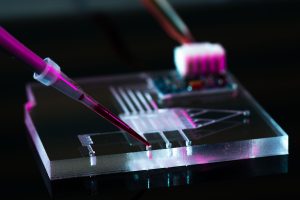Imagine how our health would improve if we could sense and detect diseases early on, at molecular scale, long before they spread and become a more serious issue. While diseases and tumors start at molecular levels, we do not feel pain or sense abnormality at such a small scale because our bodies don’t have biological tools and sensors to let us know the onset of disease at molecular scale. Over time the disease spreads, detectable symptoms arise, and we feel pain and sense abnormality. By this time the treatment options will be more invasive, more expensive, less successful and less promising. The lack of an “early warning system” is a problem that the human body has by default, but advanced technologies based on nanotechnology are promising to address this problem, along with several other exciting health benefits.
Small Technology, With Big Benefits
Nanotechnology is developed by engineering and manufacturing at nanoscale – one nanometer is one billionth of a meter. Nanotechnology, nanosensors, MicroElectroMechanical Systems (MEMS), and NanoElectroMechanical Systems (NEMS) can be used for early detection of disease symptoms. This approach allows us to detect and

diagnose diseases at molecular scale before they multiply and spread through the body, and long before they produce traditional symptoms or pain. When diseases are diagnosed in molecular level, the treatment options are less invasive, less expensive, more successful and more promising. Nanosensors, MEMS, and NEMS will dramatically improve the performance and quality of medical devices.
In addition to early detection of diseases, MEMS, NEMS, and advanced biodevices are also able to continuously monitor our health indicators and vital signs (such as heart rhythm, temperature, blood sugar, blood pressure, and oxygen saturation), and gather the related data for analysis. This real-time analysis can enable precise control systems for managing diseases such as diabetes. MEMS, NEMS, and nanosensors are widely used in wearable devices and medical implants for this purpose. Nanosensors and nanostructures are made using nanomanufacturing. Nanosensors are advanced sensing devices that measure specific characteristics and convert them to signals. These signals can be analyzed for different purposes such as detecting abnormality of cell stiffness that can be an indication of a specific disease.
Beyond Detection
Another application in medicine is using nanotechnology, MEMS, and NEMS to model and simulate human organs or entire body on microdevices and nanodevices such as a lab-on-a-chip and an organ-on-a-chip, in order to study the mechanisms of human body precisely. This approach allows us to run experiments and test new medications on these microdevices and nanodevices rather than on animals before clinical trials.
A growing application of nanotechnology in medicine is using nanorobots (nanobots). Nanorobots will compensate for the limitations of our immune system. They can be injected into the bloodstream to go through human body to not only detect diseases such as tumors but also to destroy them locally. Also, these tiny machines can be used for targeted medication delivery. In addition, nanorobots can perform surgeries at molecular scale and nanoscale. For example, they can repair the visual system inside your eyes and brains to cure blindness.
While the applications of most of these technologies for improving medicine and human health are in an early stage, they are increasingly developed to realize their potential for improving the quality of life. These medical applications of nanotechnology and many more applications that are under development show that health control and medicine is going to be more and more based on engineering and technology.